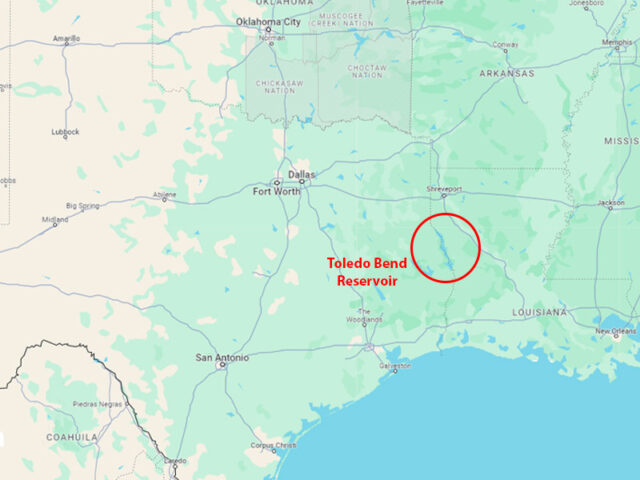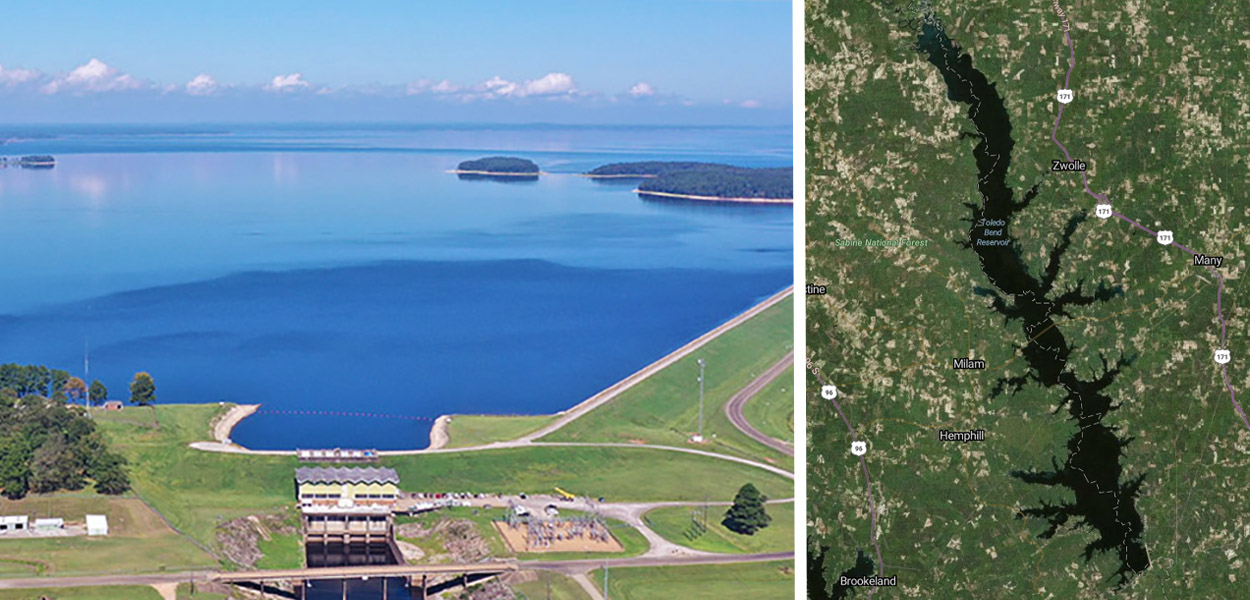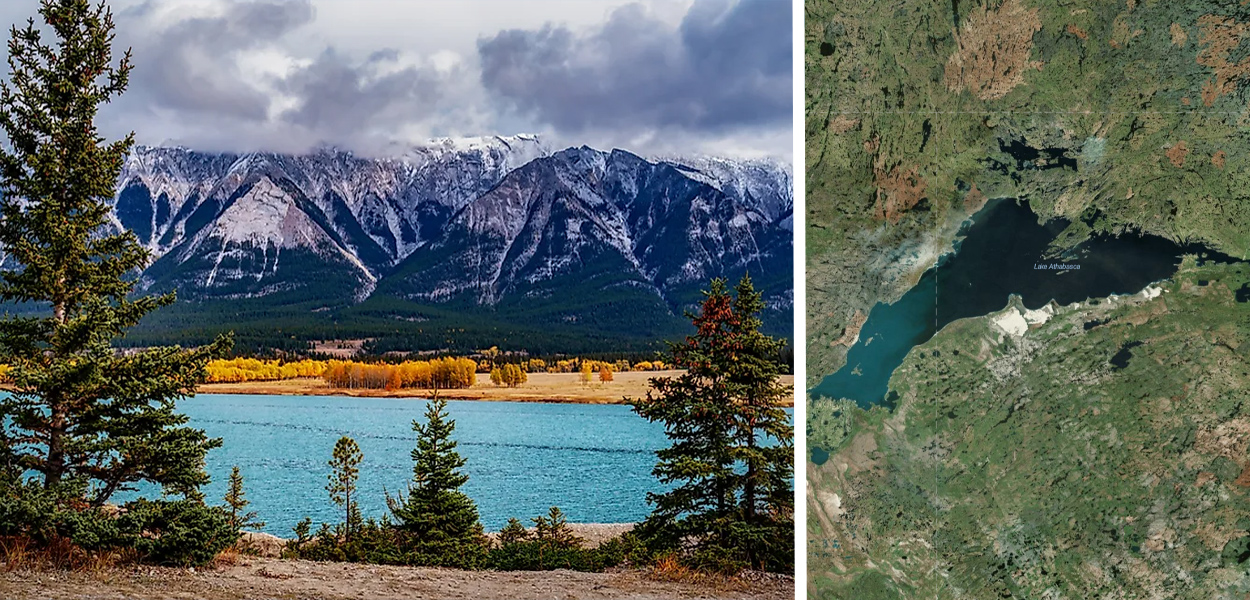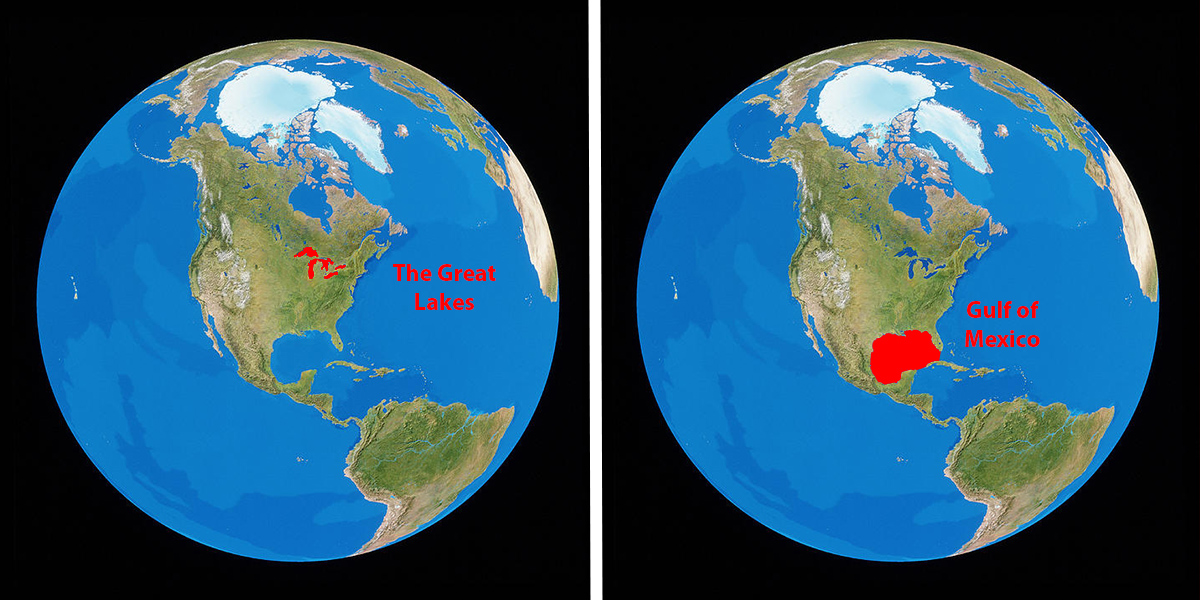The world runs on oil. Petroleum powers our transportation. It is used for heating and for the generation of electricity. Industry uses oil and its derivatives to make plastics, lubricants, solvents, and pharmaceuticals. Petroleum is a crucial and essential part of modern civilization.
Nonetheless, some aspire to find a replacement for petroleum in its role as a fuel, and it is certainly possible that there could be better alternatives. But for many of oil’s other applications, there may be no other practical options. The world needs oil–a lot of it, and it likely always will. Every day we consume massive quantities of the stuff. Since the inception of the oil-age (starting around 1850), civilization has used, and continues to use, great quantities of petroleum. But just how much?

I became curious about this topic some time ago, and began to wonder about how much oil we use, how much we have used, and how much we have left to use in the future. Searching the internet for more information, I discovered that the numbers were easy enough to come up with. More difficult though, was conceptualizing the volume of liquid the numbers actually represented. It occurred to me that some visualization models might be just the ticket.
NOTE: I have no choice but to assume that the numbers I find online are correct. There is no way for me to be sure. Fortunately, the amounts we are talking about here are so large that errors in estimate of millions of units (barrels or gallons) will be largely inconsequential.
Developing a set of workable visualization models would require some research and a little bit of math. I’m going to share both the arithmetic and investigation I did as we progress through this article. Interested parties may wish to doublecheck my calculations. Hopefully, they will let me know if they find any important discrepancies.

Annual Worldwide Oil Consumption
Let’s begin this thought experiment with some numbers on petroleum. These figures come from WorldOMeter, and they suggest that the world consumes around 35,442,913,090 barrels of oil each year. That’s certainly a big number, and there are a couple of different ways to communicate the figure this string of digits represents. The usual way of saying this number is: thirty-five billion four hundred forty-two million nine hundred thirteen and ninety. Another way–after rounding–is to say: one billion times thirty-five (1,000,000,000 x 35) and another way still reads like this: one million times thirty-five thousand four hundred forty-three (1,000,000 x 35,443). No matter how you slice it, 35,443,913,090 is a very big number.
Annual Worldwide Oil Consumption = 35,442,913,090 Barrels

To aid in visualizing the volume of oil this represents, let’s start by first converting the barrel figure to an even bigger number. We will do this by calculating the number of gallons 35,442,913,090 barrels represents. Most folks are very familiar with what a gallon is–picture a jug of milk. To get the number of gallons of petroleum used each year requires only a simple calculation. Since there are 42 gallons in each barrel of oil, we only need to multiply a barrel figure by 42 to get its gallon equivalent.
One Barrel of Oil = 42 Gallons of Oil
To determine the number of gallons of oil consumed each year we just multiply the number of barrels used each year by 42. The arithmetic looks like this 35,442,913,090 x 42 = 1,488,602,349,780 gallons of oil. The world uses one trillion four hundred eighty-eight billion six hundred two million three hundred forty-nine thousand seven hundred and eighty gallons of oil annually. Now that is a truly huge number!
35,442,913,090 Barrels = 1,488,602,349,780 gallons annual consumption

Conceptualizing and Visualization
Now we are going to need to shift gears a little bit. 1,488,602,349,780 gallons is a massive amount of liquid–a huge volume. It occurred to me that a nice way to visualize a volume of liquid that large is to find a comparable sized lake or sea. The only problem is that the volume of water held in a lake is not usually reported in gallons, but instead it is described using a unit known as the acre-foot. An acre-foot is defined as the volume of water with a surface area of one acre and a depth of one foot.

Therefore, to calculate the volume of a given lake you simply take its surface area in acres and multiply that number by its average depth in feet. In the table below you will find the volume numbers for a selection of our better known area lakes and reservoirs when they are at capacity. All lake volume data is from Texas Almanac online.
| Lewisville Lake | 563,228 acre-feet |
| Grapevine Lake | 164,703 acre-feet |
| White Rock Lake | 9,004 acre-feet |
| Lake Ray Hubbard | 452,040 acre-feet |
| Joe Pool Lake | 175,358 acre-feet |
| Eagle Mountain Lake | 179,880 acre-feet |
| Lake Arlington | 175,358 acre-feet |
So, are any of these lakes close in volume to the worldwide annual consumption of oil? The only way to be sure is to either convert the lake’s volumes from acre-feet to gallons (and/or barrels), or to convert the annual petroleum consumption figures from gallons to acre-feet. Let’s go with the second option and convert the gallon and barrel figures to acre-feet. To do this we must first determine the number of gallons in a single acre-foot. According to the Water Education Foundation that figure is put at 1 acre-foot equals 325,851 gallons. And because we know that there are 42 gallons per barrel of oil, we can convert the gallon figure to barrels by dividing by 42. Here’s the arithmetic: 325,851 / 42 = 7,758 barrels per acre-foot
1 acre-foot = 325,851 gallons = 7,758 barrels
Now, if we take the annual oil consumption figure in barrels (35,442,913,090) and divide that by the number of barrels in acre-foot (7,758) we will get the amount of oil used each year in acre-feet. Here is the calculation: 35,443,913,090 / 7,758 = 4,568,563 acre-feet.
Annual oil consumption in acre-feet = 4,568,563
So, with annual oil consumption now converted to acre-feet, I went back to the internet to try and find a body of water with a comparable volume. It was doubtful that I would find an exact match, but I hoped that I could come up with a least a few lakes or reservoirs that were close in size.
As luck would have it, I found just the kind of list I was looking for on the website Lake Lubber. According to the data they had compiled, there were several lakes–from various places around the world–that fit the bill. You can see a short list in the table included below…
| Lake Name | Location | Size in Acre-feet |
| Lake Pontchartrain | Louisiana, USA | 4,838,400 acre-feet |
| Shasta Lake | California, USA | 4,552,000 acre-feet |
| Toledo Bend Reservoir | Texas, USA | 4,477,000 acre-feet |
of annual oil consumption (4,568,563 acre-feet)
Of these three lakes, Shasta Lake in California is perhaps the closest to the number we are looking for. At 4,552,000 acre-feet it is roughly 17,000 acre-feet smaller than it needs to be a perfect match. But, since this is a Texas-based web site, we are going to select the Toledo Bend Reservoir as our reference lake. Hopefully, our Texas readers will have at least some familiarity with this reservoir, and at 4,477,000 acre-feet, Toledo Bend represents a more than adequate 98% of the volume we are looking to represent. That should be close enough for this thought exercise! According to the data, the world uses an amount of oil roughly equivalent to the volume of water in Toledo Bend Reservoir every year. That’s a massive amount of petroleum!


Total Oil Consumption To Date
Now that we’ve done the leg work to calculate the volume of annual oil use, we can easily apply the same method to other important consumption numbers. Let’s begin by doing the same conceptualization exercise with an even bigger number–the total volume of oil ever used, from the mid-1800s until now.
We’ll start this ambitious project by looking at the figures for total oil consumption to date. According to the PIN Petrochemical Chemical and Energy website, that number is somewhere between 1.1 trillion and 1.5 trillion barrels. In order to hedge our bets, we will pick the number halfway between the two… 1,300,000,000,000. That’s one trillion three hundred billion barrels of oil used worldwide since 1850!
To start the process of finding a comparable sized body of water, we need to convert this number to acre-feet. We’ll do this the same way as before–by dividing the figure in barrels by the number of barrels in an acre-foot. The arithmetic looks like this: 1,300,000,000,000 / 7,758 = 167,568,961 acre-feet of oil consumed.
Volume of total worldwide oil consumption to date = 167,568,961 acre-feet
Going back to the Lake Lubber website, it only took a moment to find a lake with a volume close in size. Lake Athabasca in Alberta, Canada has a volume of 165,242,878 acre-feet, which is just a little shy of the number we were looking for. So, if you would like to visualize how much oil we have consumed historically, all you have to do is picture Lake Athabasca!


Proven Oil Reserves
Now that we know we use A LOT of oil every year, and that we have used an even more massive amount of petroleum since the dawn of the oil industry, let’s take a look at how much consumable oil the experts believe we have remaining. For this number we will once again go to the WorldOMeter website. They fix this amount at right around 1,650,585,140,000 barrels of oil, which WorldOMeter suggest will last us approximately another 47 years.
Again, the first step is to convert this figure to acre-feet so that we can identify a comparable sized body of water–the technique remains the same. All we have to do is divide 1,650,585, 140, 000 by the number of barrels in an acre-foot. See the arithmetic below…
1,650,585,140,000 / 7,758 = 212,759,105 acre-feet
So, we have an estimated 212,759,105 acre-feet of oil reserves left in the world. That’s about 27 percent more oil left than what we have used in all of history to date! It’s certainly another massive volume of liquid! Now all we have to do is identify a comparable sized lake or sea, so it was back to the Lake Lubbers website to see what they have in their data tables.
This time, it looks like Lake Winnipeg in Manitoba, Canada–at 228,833,000 acre-feet–is the closest match.


Wasted!
Now that we know a little bit more about how much oil we use, have used, and will use, let’s take a closer look at an ancillary topic. After learning about how much petroleum we use each year, I couldn’t help but wonder how much we lose to waste. I imagine that there are innumerable ways that petroleum can be spilled or otherwise lost to waste, but for this thought experiment we will restrict ourselves to the use of the petroleum derivative gasoline here in the United States.
According to the American Petroleum Institute Americans fill up their cars and trucks approximately 38,900,000 times a day. And every one of those 38.9 million fill ups creates an opportunity for loss of gasoline to waste. Regardless of whether you are just topping off the tank, or filling up from near empty, the opportunity to spill a little bit of gas as you move the nozzle to and from the pump remains the same. Let’s suppose–just for the sake of argument–that somewhere around one teaspoon of gasoline is spilled in this fashion every time someone fills up their gas tank. Remember, this is just a guestimate. I have no way of knowing exactly how much gas is spilled at each fill up, but a teaspoon seems a reasonable estimation.
A volume of liquid described by a teaspoon is not very big. A teaspoon is roughly equal to 0.17 fluid ounces or 5 milliliters. That’s somewhere in volume between a packet of tabasco sauce (0.11 fluid ounces) and a packet of coffee creamer (0.38 fluid ounces). It takes 768 teaspoons of liquid to equal one gallon. That’s a lot of teaspoons!
One teaspoon = 0.17 fluid ounces = 5 milliliters and 768 teaspoons = one gallon

That’s somewhere in volume between a packet of tabasco sauce (0.11 fluid ounces)
and a packet of coffee creamer (0.38 fluid ounces).
Now, we have enough information to create an estimate for how much gasoline gets wasted at gas stations each year due to spillage. We can start by noting that if roughly one teaspoon of gasoline is spilled with each fill up, and there are 38.9 million fill ups daily, then that means 38,900,000 teaspoons of gasoline are lost to waste each and every day.
38,900,000 teaspoons of gasoline are lost to spillage at gas stations around America every day
Next, let’s cover the teaspoon figure to gallons by dividing the 38,900,000 teaspoon figure by the number of teaspoons in a gallon (768 teaspoons). After the arithmetic we find that 38.9 million teaspoons equals 50, 651 gallons. That’s 50,651 gallons of gasoline that get lost to spillage each day in the United States alone.
38,900,000 teaspoons equals 50,651 gallons
The calculation to determine how much gasoline is wasted in this way each year is easy, we simply multiply the number of gallons lost each day by the number of days in a year. The arithmetic looks like this:
50,651 gallons x 365 days = 18,487,615 gallons of gasoline lost to waste each year
18,487,615 gallons is a huge number, especially when you consider that it is used to quantify an amount of waste. But, again, the number is so large that it is difficult to envision just how much gasoline we are talking about. So, let’s try to set up an example that will help us conceptualize this amount. This time we will use an Olympic-sized swimming pool as our reference.

An official Olympic-sized swimming pool measures 50 meters long by 25 meters wide by 2 meters deep. A pool like this will contain right around 660,430 gallons of water, a volume far short of the 18,487,615 gallons of wasted gasoline calculated above. So, now let’s divide 18,487,615 by 660,430 to compute how many Olympic-sized pools would be required to hold all that wasted gasoline. Solving for the quotient rounding up just a bit gives us the number 28. That means it would take 28 Olympic-sized swimming pools to hold all of the gasoline that is lost to spillage at gas stations in the United States each year. Man, that is a lot of wasted gasoline!
28 Olympic-sized swimming pools of gasoline are lost to spillage at gas stations in the US each year

Imagine if there was someway to recover all that spilled gasoline. How much would it be worth? Well, according to the American Automobile Association the average price for a gallon of gas in Texas right now is right around three dollars and fifty cents. Let’s do the multiplication… 18,487,615 gallons of gasoline x $3.50 per gallon = $64,706,652
18,487,615 gallons of gasoline x $3.50 per gallon = $64,706,652
Wow! That’s a lot of mullah! Wouldn’t it be amazing if that spilled gasoline could be recovered somehow? There are a lot of reasons why it might be desirable. The dollar value of the spilled gasoline is substantial and the waste is egregious, but the motivation to recover it will probably always be lacking. Further, the spilled gasoline has already been paid for by the customer, meaning the monetary loss goes on the balance sheet of the customer, not the gas station. Surely, the effort required to capture the lost gasoline would be expensive, and the volume to be recovered at each gas station would be relatively small. The economics may never justify making the attempt.
One More Contextualization
We don’t hear it discussed much these days, but starting back in the 1970s, and resurfacing from time to time in the following years and decades, is a buzz about a concept known as peak oil. Peak oil is described as the time when the petroleum supply and oil production is no longer able to keep up with demand.
Peak Oil – the theorized point in time when the maximum rate of global oil production will occur, after which oil production will begin an irreversible decline.. (As defined by Wikipedia)
The idea that we would run out of oil began to gain traction during the energy crisis of the 1970s. The Carter Administration even went as far as to predict that the world would run out of oil within 35 years–a prediction that expired in 2011.
Talk about peak oil picked up again during the administrations of George W. Bush and Barack Obama. The target dates were generally set at around 15 years in the future by both presidents. Just like with Carter’s earlier guess, George W. Bush’s predictions have also now largely expired, and president Obama’s estimations are rapidly approaching their expiry dates as well. In 2007, the Government Accountability Office (GAO) was a bit more conservative in their predictions, placing their projection for peak oil at somewhere between 2007 and 2040. If correct, that gives us only 16 more years… mark your calendars.
The numbers that describe the amounts of oil that we use, have used, and will use are enormous on a human scale. But, an interesting thing happens if we relate those volumes to the size of the entire planet Earth. When you make that comparison, the volume of all oil used–and to be used–shrinks away to insignificance. The volumes these amounts represent virtually vanish. The same is true if you compare the volume of petroleum used to the volume of water contained in the Earth’s oceans and seas, or the volume of gases contained in the planet’s atmosphere. The amount of consumed oil is a tiny, tiny fraction of the volume of the planet Earth, or its oceans and seas, or its atmosphere. The amount of oil burned as fuel–as opposed to its myriad of other uses–is even smaller.

What this means is that there is a WHOLE LOT of room for there to be more petroleum on this planet. That doesn’t mean that there is more oil, only that there IS a possibility for more. How much more is anybody’s guess. My suspicion is that there is a virtually unlimited supply of oil still available on planet Earth. A volume of oil the size of Great Lakes would last for centuries. A volume the size of the Gulf of Mexico would be virtually inexhaustible. Both still represent only a small fraction of the total size of the planet Earth. The quantity of this petroleum that will be recoverable in the future will likely depend to a great degree on how badly we want to access it and what technology is available to help us reach it.


